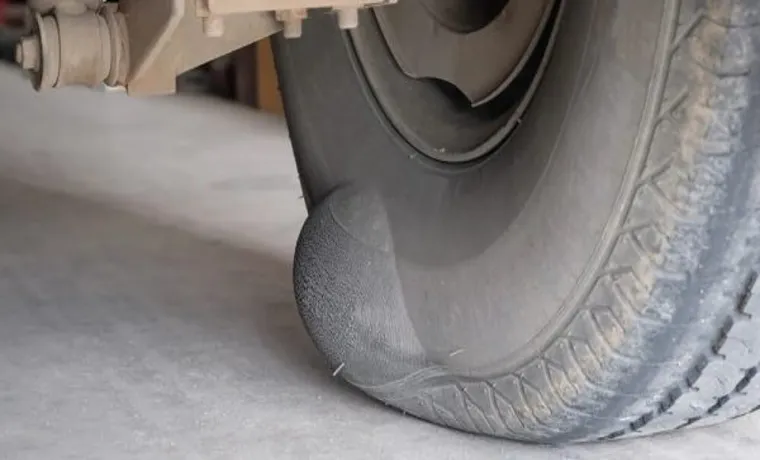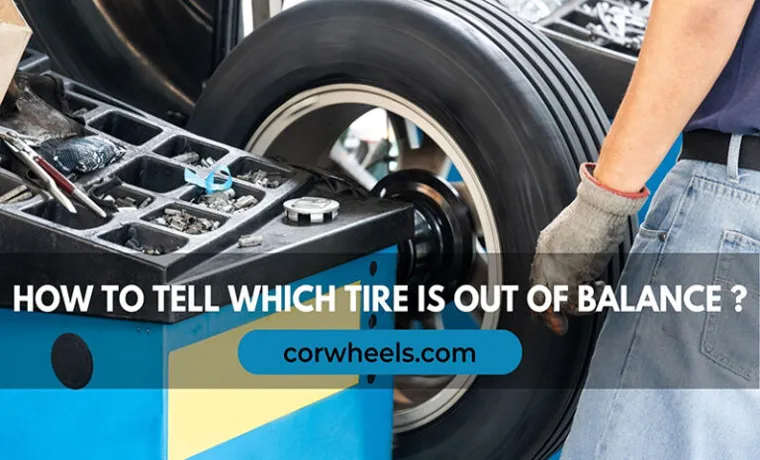Have you ever been driving down the road and felt a strange vibration in your car that seems to be coming from the tires? If so, there’s a chance that your tire could be out of balance. While this may not seem like a big deal, an unbalanced tire can cause serious damage if it’s not addressed. In this blog, we’ll explore how to tell if your tire is out of balance and what you should do about it.
When a tire is out of balance, it means that it’s unevenly distributing its weight. This can cause it to spin unevenly, which is what creates that strange vibration. You may notice the vibration getting worse as you speed up, or it may only be noticeable when you’re driving on certain roads.
Either way, if you feel a vibration in your car, it’s always best to get it checked out by a professional. There are a few ways to tell if your tire is out of balance without having to take it to a mechanic. One way is to pay attention to how your car handles.
If you feel like it’s pulling to one side or the other, or if it feels like it’s harder to steer, there’s a good chance that your tire is out of balance. You may also notice that your car is louder than usual or that your gas mileage has decreased. So what should you do if you suspect that your tire is out of balance? The first step is to take your car to a reputable mechanic.
They’ll be able to diagnose the problem and tell you if you need to have your tire balanced or if you need a new tire altogether. If they do recommend balancing your tire, it’s a relatively simple fix that shouldn’t take too long or cost too much. Overall, it’s important to pay attention to how your car is handling and to take any strange vibrations seriously.
By being proactive and addressing the issue early on, you can avoid more serious damage down the line. So if you suspect that your tire is out of balance, don’t wait – take your car to a mechanic today.
Table of Contents
What is Tire Balance?
Tire balance refers to evenly distributing the weight of a tire and wheel assembly so that it spins smoothly while driving. When a tire is out of balance, you may notice vibrations or shaking in the steering wheel, seat, or floorboard while driving at certain speeds. Additionally, an unbalanced tire can cause uneven wear on the tire tread, which can lead to a shortened lifespan of the tire.
To tell if your tire is out of balance, pay attention to any unusual vibrations while driving, and look for any unusual wear patterns on the tire tread. If you suspect that your tire is out of balance, it is important to have it inspected by a professional mechanic who can identify the problem and recommend a proper solution. Regular tire balancing and rotation can help prevent issues with tire wear and improve the performance and safety of your vehicle on the road.
So, give your tires the attention they deserve to ensure a smooth and enjoyable driving experience.
Explanation of Tire Balance
Tire balance is the distribution of weight around the circumference of a tire to ensure that it rotates smoothly without causing any vibrations. When a tire is not balanced, it can cause excessive wear and tear on the tires, suspension components, and steering system, which can lead to a bumpy ride and reduce the overall life of the tire. To fix this issue, a technician will use a balancing machine to determine the correct weight distribution and attach small weights to the wheel rim.
This process helps to evenly distribute the weight of the tire and wheel assembly, resulting in improved handling, improved fuel efficiency, and increased safety. Regular tire balancing is essential for maintaining optimal performance and prolonging the life of your tires, so make sure to have it done regularly by a trained professional.

Symptoms of a Tire Out of Balance
Have you ever felt your car vibrating or shaking while driving? This could be a sign that your tire is out of balance. A tire that’s out of balance occurs when the weight of the tire and wheel assembly isn’t evenly distributed, causing it to wobble and produce vibrations. These vibrations can be felt on the steering wheel or throughout the vehicle’s cabin.
You may also notice uneven tire wear, particularly on the outer edges of the tire. In some cases, you may even hear a thumping or humming sound coming from the tire. If you suspect that your tire is out of balance, it’s crucial to have it checked out by a qualified technician.
Ultimately, correcting the balance issue will help improve your vehicle’s ride quality and prevent more significant mechanical problems down the line. So, if you ever experience any of these symptoms, take your vehicle to a mechanic for a proactive solution.
Vibrations While Driving
When driving, it’s important to pay attention to any vibrations or shaking sensations you feel. This could be a sign of an imbalanced tire, which may occur when one section of the tire is heavier than the rest. Symptoms of a tire out of balance can include vibrations in the steering wheel, floorboard, or seat while driving.
You may also notice uneven tire wear, as the unbalanced tire causes uneven pressure on the pavement. If you feel any vibrations while driving, it’s best to have your tires inspected as soon as possible to avoid any potential issues down the road. A tire that’s out of balance can cause excess strain on your vehicle, leading to premature wear and tear on your tires, suspension, and steering system.
So, if you’re experiencing any of these symptoms, get your tires inspected by a professional to ensure your safety and the longevity of your vehicle.
Uneven Wear on Tires
Uneven wear on tires can be caused by a variety of factors, but one common culprit is an out-of-balance tire. This occurs when the weight distribution of the tire and wheel assembly is uneven, causing the tire to vibrate and wear unevenly over time. Some common symptoms of a tire out of balance include a noticeable vibration at high speeds, uneven wear patterns on the tire tread, and a wobbling sensation in the steering wheel.
If left unaddressed, an unbalanced tire can lead to more serious safety issues, such as decreased handling, increased tire wear, and potential tire failure. To prevent these problems, it’s important to have your tires balanced periodically, especially after any significant changes to your vehicle’s suspension or tire size. By keeping your tires properly balanced, you can not only extend their lifespan but also improve your driving experience on the road.
Steering Wheel Vibrates
If you’ve ever experienced a steering wheel vibration, then you know how unsettling and distracting it can be. More often than not, the culprit is an unbalanced tire. But what exactly causes a tire to become unbalanced, and how can you tell if you have a tire out of balance? Well, first of all, a tire can become unbalanced simply from wear and tear over time.
Another reason may be due to a damaged or bent wheel. Symptoms of a tire out of balance include the aforementioned steering wheel vibration, as well as a vibrating seat or floorboard and uneven tire wear. If you’re experiencing any of these symptoms, it’s essential to get your tires checked as soon as possible.
An unbalanced tire not only reduces your vehicle’s performance but can also lead to potentially dangerous driving conditions. Remember, it’s always better to be safe than sorry when it comes to the safety of yourself and your passengers.
How to Check Tire Balance
Do you feel a wobbling or shaking sensation while driving your car? It could be a sign that your tire is out of balance. Checking the balance of your car tire is essential for a smooth driving experience and ensuring tire longevity. One way to tell if your tire is out of balance is by performing a visual inspection.
Check if there are any irregular wear patterns or bulges on the tire surface. Another way to test for balance is by using a balancing machine. This machine will measure the weight distribution of the tire and locate the heavy spots.
Once located, counterweights can be added to balance the tire. If you’re unsure about your tire balance, it’s always best to consult a professional mechanic to avoid any further damage to your car. Don’t ignore the signs of an imbalanced tire, as it could lead to unsafe driving conditions and expensive repairs.
Inspection of Tread Wear
When it comes to maintaining your car, checking the balance of your tires is a crucial step. Uneven wear and tear on your tires can cause poor handling and even affect your gas mileage. Fortunately, checking your tire balance is a simple task that can be done with a few basic tools.
First, check the inflation pressure and ensure that all four tires are inflated to the recommended level. Then, use a jack to lift each tire off the ground and spin it slowly. If the wheel wobbles or vibrates, it may indicate that the tire is unbalanced.
In this case, head to a professional mechanic to have the tire balanced. Regularly checking the balance of your tires can help keep you and your vehicle safe on the road, while also extending the life of your tires. So why not add it to your regular maintenance routine?
Visual Inspection of Tires
When it comes to maintaining your vehicle, proper tire balance is crucial to ensuring a smooth and comfortable ride. You can easily check your tire balance by observing any uneven wear on the tread or feeling for vibrations while driving. If you notice either of these symptoms, it’s important to take your vehicle to a trusted mechanic or tire specialist to have them properly balance your tires.
This process involves adding small weights to the rim of the tire to balance out any inconsistencies. By doing so, you’ll not only improve your driving experience but also help to extend the life of your tires and save money in the long run. So don’t overlook this important aspect of vehicle maintenance and make sure to check your tire balance periodically to keep your vehicle running smoothly and safely on the road.
Check for Wheel Damage
Tire balancing is a crucial aspect of regular vehicle maintenance. It helps to ensure smooth handling and optimal performance of your car. To achieve this, it’s essential to check your wheels for damage, which could cause an imbalance.
Start by visually inspecting your tires for cuts, cracks, or bulges, which could be indicative of physical damage. Additionally, check if there’s any sign of wear on the tire’s surface, which could be another indicator of a problem. To check for wheel damage, you should take note of any vibrations you feel while driving.
If you experience any shaking or vibration while driving, it could be a sign of a misaligned tire. In conclusion, checking your wheels for damage is essential to maintaining proper tire balance. Taking this step is particularly crucial if you feel any vibration while driving.
By inspecting your tires visually and taking note of any physical signs of damage, you can take quick action and ensure that your wheels remain in good condition. Remember that ensuring proper tire balance is vital to your car’s optimal performance and your safety on the road. So, don’t overlook this important aspect of car maintenance.
Using a Balancing Machine
Checking tire balance is an important aspect of vehicle maintenance as it increases tire life, provides a smooth ride, and enhances safety on the road. One of the most effective ways to check tire balance is by using a balancing machine. This machine determines imbalances in the tires by spinning them at high speeds and measuring the amount of vibration.
The technician will then add or remove weights on the tires until they are well-balanced. Uneven weight distribution on the tires may result in irregular wear and tear, reduce traction, decrease gas mileage, and cause unpleasant vibrations. Checking tire balance regularly will ensure optimal performance and longevity of your tires, while also maximizing safety on the road.
So, next time you experience uneven tire wear, vibration, or unusual handling, consider taking your vehicle to a professional technician for a tire balance check.
Tips for Preventing Tire Imbalance
If you’re wondering how to tell if a tire is out of balance, there are a few signs you can look for. One common indicator is vibration, which can be felt in the steering wheel or through the floor of the car. A tire that’s out of balance can also cause uneven wear, which can create a thumping sound while driving.
To prevent tire imbalance, it’s important to have your tires balanced regularly, especially after getting new tires or rotating them. Additionally, keeping your tires properly inflated and aligned can help prevent imbalance and extend the lifespan of your tires. If you notice any of the symptoms of tire imbalance, it’s important to have your tires serviced by a professional as soon as possible to prevent further damage and ensure your safety on the road.
Regular Tire Rotations
Regular tire rotations are an important aspect of vehicle maintenance that can help prevent tire imbalance. Uneven tire wear can cause a variety of issues, from decreased fuel efficiency to a less comfortable ride. To prevent this, it is recommended to rotate your tires every 5,000 to 7,500 miles, depending on the make and model of your vehicle.
By rotating your tires regularly, you can distribute the wear more evenly, which can help extend the lifespan of your tires and improve overall performance. Properly balanced tires can also make a big difference in the handling and stability of your vehicle, providing a safer and more enjoyable driving experience. So, if you want to avoid the hassle and expense of premature tire replacements, make sure to schedule regular tire rotations with your mechanic or tire specialist, and keep your vehicle running smoothly on the road!
Proper Tire Inflation
Proper tire inflation is crucial when it comes to maintaining balance and preventing tire issues. One tip for preventing tire imbalance is checking your tire pressure regularly. Low tire pressure can cause irregular wear and tear, leading to imbalanced tires.
On the other hand, overinflating your tires can make them more prone to damage from bumps and potholes. It’s important to follow the recommended pressure levels provided by your manufacturer. Another tip is to rotate your tires every 5,000 to 7,000 miles.
This can prevent uneven wear and tear, keeping your tires balanced and extending their lifespan. Don’t forget to also check your wheel alignment and balance periodically. Proper tire inflation and maintenance can help prevent accidents on the road, so take the time to ensure your tires are in good condition.
Alignment Check
Have you ever experienced your vehicle shaking or vibrating while driving? This could be a sign of tire imbalance, a common issue that happens when the distribution of weight around the tire is uneven. Not only is this issue annoying, but it can also cause premature tire wear, decreased fuel efficiency, and even pose a safety risk. However, tire imbalance can easily be prevented through proper alignment checks and maintenance.
Regularly inspecting your tires, ensuring proper air pressure, and rotating them every 5,000-7,000 miles can all help prevent imbalance. Additionally, it’s important to have your alignment checked at least once a year or if you notice any unusual wear on your tires. By taking these simple steps, you can avoid tire imbalance and keep your vehicle running smoothly on the road.
Conclusion
In conclusion, there are several telltale signs that your tire is out of balance. If you feel vibration in the wheel, notice uneven tread wear, or experience a bumpy ride, it might be time to get your tires checked. In other words, if your car starts feeling like a shaky washing machine, it’s probably time to balance those tires.
Don’t wait until you feel like you’re driving on a makeshift rollercoaster; take care of your tires and keep your ride smooth and steady.”
FAQs
What are the Symptoms of an Out of Balance Tire?
Symptoms of an out of balance tire include vibration in the steering wheel or seat, unusual tread wear, and difficulty handling the vehicle.
How Often Should You Have Your Tires Balanced?
It is a good idea to have your tires balanced every 5,000 to 7,000 miles or whenever you notice a vibration in the steering wheel or seat.
Can an Out of Balance Tire Cause Damage to Your Vehicle?
Yes, an out of balance tire can cause premature wear on your suspension, steering components, and tires.
How is Tire Balancing Different from Wheel Alignment?
Tire balancing involves equalizing the weight of the tire and wheel assembly, while wheel alignment involves adjusting the angles of the wheels to ensure they are parallel and perpendicular to the ground.
Can You Balance Tires at Home?
While it is possible to balance your own tires using a balancing machine, it is recommended to have a professional do it to ensure accuracy and proper balancing.
How Much Does Tire Balancing Cost?
The cost of tire balancing can vary depending on the shop and location, but it typically ranges from $20 to $100 per tire.
What Causes Tires to Become Unbalanced?
Tires can become unbalanced due to normal wear and tear, hitting potholes or curbs, and improper installation or maintenance.




